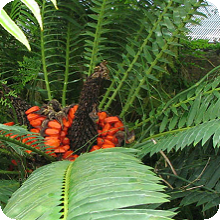| |||
| Division: Cycadophyta |
| Class: Cycadopsida |
| Order: Cycadales |
| Family: Zamiaceae |
| Genus: Encephalartos |
| Species: E. lebomboensis |
Conservation Status: |

E. lebomboensis
Lebombo CycadE.lebomboensis is said to be one of the most popular cycads in cultivation, although there is some confusion about its identity. Several populations of what were previously regarded as E. lebomboensis are now regarded as E. senticosus, including most of those found on the Lebombo Mountains.
It was first described in 1949 by Dr Inez Verdoorn. Its centre of distribution was the Lebombo Mountains, stretching from northern KwaZulu-Natal through Swaziland and up into Mpumalanga. In 1995 Dr Piet Vorster re-named the plants from the central part of the geographic range (the Lebombo range from 50 km north of Siteki in Swaziland to the Josini Dam/Pongolapoort Dam in Kwazulu-Natal) as E. senticosus, based mainly on differences in their cones. It was from this latter site, when the dam was developed in the 1960s, that many cycads were collected and entered the nursery trade as E. lebomboensis, although they are now E. senticosus.
Today E. lebomboensis is described as occuring in two areas, although this view is debated by some. There is a northern form around Mananga in Mpumalanga and a southern form centred around Piet Retief on the upper Pongola River Valley. Both forms are commonly found in cultivation.
This is a medium to large cycad with stems which can grow to 4 m long. It is often procumbent with a crown of light to dark green, glossy leaves. It grows singly or in clumps of up to eight stems. It forms numerous suckers from the base and occasional offsets on the trunks. Stems of the Piet Retief form are shorter and stouter.
The differences between the forms are slight, with the Piet Retief form having narrower leaflets and female cones which are usually solitary, barrel-shaped and greeny- cream, as opposed to more apricot yellow, egg-shaped cones of the Mananga form.
Cultivation:
This cycad is suited to tropical and warm temperature regions. It is easily grown, hardy in full sun or light shade, relatively fast growing and transplants easily. It requires excellent drainage and may be damaged by heavy frosts, but can withstand light frosts. This cycad can be grown from seed or from the removal of suckers which transplant readily.
For more about the pests of cycads, please see Encephalartos horridus.
When obtaining cycads for your garden, please be sure to buy from reputable sources and guard against doing anything that might endanger wild populations of these plants.
| full sun | green | low watering | average growth | frost-resistant | common |
This cycad is suited to tropical and warm temperature regions. It is easily grown, hardy in full sun or light shade, relatively fast growing and transplants easily. It requires excellent drainage and may be damaged by heavy frosts, but can withstand light frosts. This cycad can be grown from seed or from the removal of suckers which transplant readily.
For more about the pests of cycads, please see Encephalartos horridus.
When obtaining cycads for your garden, please be sure to buy from reputable sources and guard against doing anything that might endanger wild populations of these plants.
Available E. lebomboensis at Africa Cycads:
|

